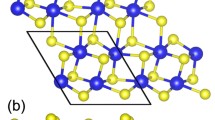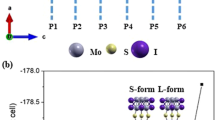Abstract
We have investigated the electronic structure and transport properties of the transition metal dichalcogenides composite WX2-MoX2 (X≡S, Se, Te) nanowires under the external strain, in the method of the first-principles calculation combining the Density functional theory (DFT) and the Non-equilibrium Green’s function (NEGF). First, we have designed the two terminal electron transport devices based on the stable transition metal dichalcogenides (TMDs) WX2-MoX2 (X≡S, Se, Te) composite nanowires for the first time. Second, the electronic structure and transport properties of the WS2-MoS2 composite nanowire have been demonstrated to be more sensitive to the external strain when compared to that of the composite WSe2/Te2-MoSe2/Te2 nanowires, the external compressive strain may significantly enchance the differential negative resistance (DNR) effect of the WSe2-MoSe2 composite nanowire based device, while the stretch strain should induce the interesting DNR in the WTe2-MoTe2 composite nanowire device. Finally, the obtained results have been physically explained from the integral area of the transmission coefficient in the bias voltage window, and may be of importance in the design of the nanoelectronic devices based on transition metal dichalcogenides composites.
Graphical abstract
The current–voltage characteristic curves of the two terminal a WS2-MoS2, b WSe2-MoSe2, and c WTe2-MoTe2 composite nanowires under the strain of – 7–7%. The pentagram marked (black) solid line indicates the unstrained case, the solid and hollow circle marked (red) dashed lines indicate the 3% and − 3% strain case, the solid and hollow squares marked (blue) dashed-dot lines denote the 5% and − 5% strain case, while the solid and hollow triangles marked (purple) dotted lines illustrate the 7% and − 7% strain case, respectively. The current of the unstrained WS2-MoS2 composite nanowire device is nearly 0 in the bias range of [− 0.2 V, + 0.2 V] while that should decrease with the increase of the bias voltage in the range of [+ 0.8 V, + 1.0 V], the system behaves an interesting negative differential resistance (NDR) effect. Additionally, the device behaves typical semiconducting feature in the whole bias voltage range under the − 3% compressed strain, while the device current should decrease with the increase of the bias voltage at the regime of [± 0.4 V, ± 0.6 V] and [± 0.8 V, ± 1.0 V], respectively, under the 3% stretched strain. The device should behave significant NDR effect in the bias voltage of [± 0.6 V, ± 0.8 V] under the 5% stretched strain, while one observes the NDR effect at bias voltage range of [− 0.8 V, − 1.0 V], [− 0.4 V, − 0.6 V] and [+ 0.4 V, + 1.0 V], respectively, under the 7% stretched strain. Furthermore, as demonstrated in (b), the current–voltage characteristics curve of the two terminal WSe2-MoSe2 composite nanowires electron device under the strain of – 7–7% behaves typical metallic features. The external strain should significantly enhance the NDR effect of the WSe2-MoSe2 composite nanowires electron device, especially in the compressed – 3– − 7% strain cases. Finally, as illustrated in (c), the current–voltage curve of the two terminal WTe2-MoTe2 composite nanowires electron device under the strain of – 7–7% presents the typical semiconducting features. The observed NDR effect of the composite nanowire devices has been physically explained from the transmission spectra and the integral area of the transmission coefficient in the bias voltage window.










Similar content being viewed by others
Data availability statement
This manuscript has no associated data or the data will not be deposited. [Authors' comment: All the first-principle calculated data have been provided in Table 1 of the paper.]
References
J. Li, Y. Duan, Y. Zhou, RSC Adv. 7, 53696–53705 (2017)
Y.H. Zhou, G.M. Zhai, T. Yan, J.S. Francisco, H. Tian, Q. Huang, S.Y. Du, J. Phys. Chem. C 122, 14908–14917 (2018)
S.S. Yu, C. Wang, W.T. Zheng, Phys. Status Solidi A 208, 2328–2331 (2011)
H. Wang, Y. Wang, B. Bai, Appl. Surf. Sci. 531, 147347 (2020)
H. Zhao, X.W. Zhang, X.C. Liu, Commun. Theo. Phys. 70, 829 (2018)
R. Tenne, L. Margulis, M. Genut, Nature 360, 444–446 (1992)
O. Ávalos-Ovando, D. Mastrogiuseppe, S.E. Ulloa, Phys. Rev. B 99, 035107 (2019)
M. Liu, J. Shi, Y. Li, X. Zhou, D. Ma, Y. Qi, Y. Zhang, Z. Liu, Small 13, 1602967 (2017)
B. Kirubasankar, P. Palanisamy, S. Arunachalam, Chem. Eng. J. 355, 881–890 (2019)
N.K. Nepal, L.P. Yu, Q. Yan, Phys. Rev. Mater. 3, 073601 (2019)
M.H. Chang, C.J. Chen, M.S. Lai, New Engl. J. Med. 26, 1855–1859 (1997)
S. Larentis, B. Fallahazad, E. Tututc, Appl. Phys. Lett. 101, 223104 (2012)
B. Radisavljevic, A. Radenovic, J. Brivio, A. Kis, Nat. Nanotechnol. 6, 147–150 (2011)
M.M. Perera, M.W. Lin, H.J. Chuang, B.P. Chamlagain, ACS Nano 7, 4449–4458 (2013)
Y. Zhou, Y. Yang, Y. Guo, Appl. Surf. Sci. 497, 143764 (2019)
L. Hui, Z. Yi, J. Dong, Nanoelectronics and Materials Development (InTech, USA, 2016), pp. 117–139
D. Çakır, F.M. Peeters, Phys. Rev. B 89, 245403 (2014)
S. Oshima, M. Toyoda, S. Saito, Phys. Rev. Mater. 4, 026004 (2020)
M. Tan, L. Zhang, W.Z. Liang, Acta Phys. Chim. Sin 35, 385–393 (2019)
M. Ghorbani-Asl, S. Borini, A. Kuc, Phys. Rev. B 87, 235434 (2013)
J. Taylor, H. Guo, J. Wang, Phys. Rev. B 63, 245407 (2001)
D. Waldron, P. Haney, B. Larade, A. Mac Donald, H. Guo, Phys. Rev. Lett. 96, 166804 (2006)
D. Waldron, V. Timoshevskii, Y. Hu, K. Xia, H. Guo, Phys. Rev. Lett. 97, 226802 (2006)
J.P. Perdew, A. Zunger, Phys. Rev. B 23, 5048 (1981)
C. Lee, W. Yang, R.G. Parr, Phys. Rev. B 37, 785 (1988)
J.P. Perdew, K. Burke, M. Ernzerhof, Phys. Rev. Lett. 77, 3865 (1996)
B. Hammer, L. Hansen, J. Nørskov, Phys. Rev. B 59, 7413 (1999)
B. Guo, Q. Liu, E. Chen, H. Zhu, L. Fang, J.R. Gong, Nano Lett. 10, 4975 (2010)
A. Copple, N. Ralston, X. Peng, Appl. Phys. Lett. 100, 2939 (2012)
M. Brandbyge, J.L. Mozos, P. Ordejón, J. Taylor, K. Stokbro, Phys. Rev. B 65, 165401 (2002)
Acknowledgements
This work was supported by the National Natural Science Foundation of China (Grant Nos. 11664010 and 11264013), the Hunan Provincial Natural Science Foundation of China (Grant Nos. 2021JJ30549 and 2017JJ2217), the Scientific Research Fund of Hunan Provincial Education Department of China (Grant No. 18A293), and the Research Program of Jishou University (Grant Nos. Jdy19039, Jdy20031, JGY202108, and JGY202118).
Author information
Authors and Affiliations
Contributions
All authors listed have made a substantial, direct and intellectual contribution to the work, and approved it for publication.
Corresponding author
Rights and permissions
About this article
Cite this article
Lin, L., Cheng, Y., Luo, S. et al. Electron transport properties of the transition metal dichalcogenides composite WX2-MoX2 (X≡S, Se, Te) nanowires under the external strain. Eur. Phys. J. B 95, 110 (2022). https://doi.org/10.1140/epjb/s10051-022-00374-1
Received:
Accepted:
Published:
DOI: https://doi.org/10.1140/epjb/s10051-022-00374-1




